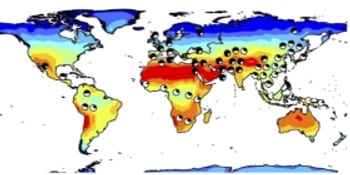 Modern lifestyles are often blamed for diseases such as obesity, high cholesterol, heart disease and diabetes. But from an evolutionary standpoint those ailments may have roots in changes that occurred tens of thousands of years ago, when humans first left balmy Africa for more northerly climes.
Modern lifestyles are often blamed for diseases such as obesity, high cholesterol, heart disease and diabetes. But from an evolutionary standpoint those ailments may have roots in changes that occurred tens of thousands of years ago, when humans first left balmy Africa for more northerly climes.
Climate is already known to be partially responsible for the variations seen in body shape and size among humans. It’s no accident that Arctic Inuit tend to be short and squat while East African Maasai are long and lean.
Genetic Adaptations
Researchers at the University of Chicago recently hypothesized that climate might also have influenced genetic differences in metabolism.
“As some populations migrated out of Africa to much cooler climates, there would have been pressure to adapt to their new settings by boosting the processes that produce and retain heat,” said Anna Di Rienzo, a professor of genetics at the university.
A study published by Rienzo and her colleagues in today’s PLoS Genetics shows that genetic adaptations to colder climates do seem to affect susceptibility to many common metabolism-related disorders.
The Study
The scientists tested their idea by looking at SNPs in metabolism genes in 54 populations from around the world. They found that as a group, variations in these genes are correlated with climate measures such as temperature, humidity, and UV exposure.
Some of the variations that increased in frequency as people moved farther out of Africa have turned out to be harmful in the modern world. For example, the protein made by the FABP2 gene helps the body transport, absorb, and metabolize fats. A version of a SNP in this gene that is more prevalent in populations at higher latitudes causes the protein to bind fats more tightly. It has also been associated with increased insulin resistance, higher cholesterol and triglyceride levels, and more abdominal fat.
Adaptations for Colder Climates
But adaptations to colder weather that took place thousands of years ago don’t necessarily doom a population to a higher risk for disease today. A version of a SNP in the PON1 gene (which encodes a protein involved in dilation of blood vessels) is more common in populations from cooler regions. That version is associated with decreased risk for coronary artery disease, stroke, and heart attack.
According to the study’s authors, whether a variation increases or decreases risk for metabolic disorders will depend on exactly how the variation helped people deal with their new environment. For example, a variation in the LEPR gene probably helped early humans generate more body heat. Today this variant is associated with lower BMI. But the variation in the FABP2 gene discussed above, probably helped people stay warm by increasing BMI.

The frequencies of the two different versions of SNP rs662 in the PON1 gene are shown as a pie chart for each of the tested populations against a background map showing summer surface solar radiation. (From Hancock et al. (2008) Adaptations to climate in candidate genes for common metabolic disorders. PLoS Genet 4(2): e32. doi:10.1371/journal.pgen.0040032.g001)



